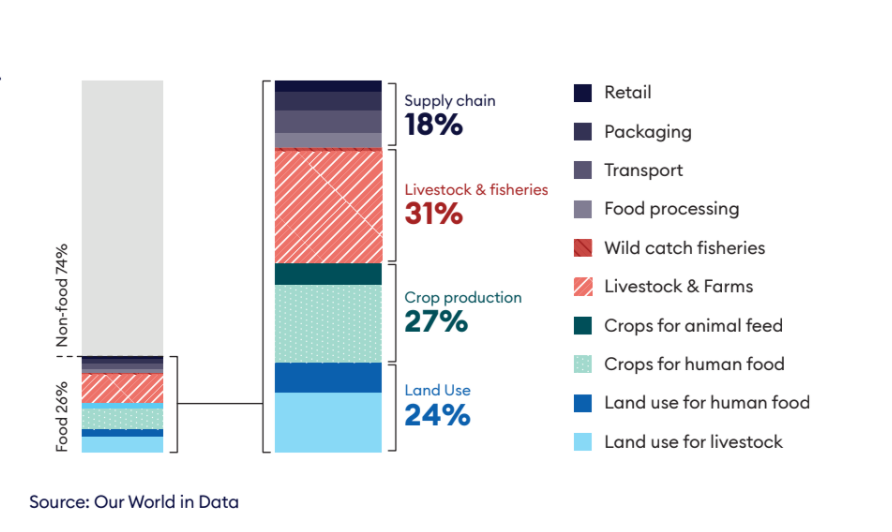The global supply chains for food, agricultural products and technology experienced an unprecedented shock due to the pandemic. Despite the disruption trade in foodstuff remained remarkably resilient, highlighting the essential role of food supply in times of crisis. Nevertheless, global food systems are undergoing a structural transformation that is necessary, not only to feed the world’s growing population, but also to prevent damaging impacts of climate change and environmental degradation.
The globalisation of supply and markets has seen agri-food sectors become more integrated with other sectors of the economy, both within countries and across those value chains. International trade in food and agriculture has more than doubled in real terms between 1995 and 2018 to reach US$1.5trn.1 The total global food and beverages market was worth almost US$6trn in 2019, following annual growth of 5.7% since 2015. Prior to the pandemic, the market was forecast to reach a value of US$8.6trn by 2025, before climbing to nearly US$12trn by the end of the decade.2
The global food system has also become more “global”, as exports from developing countries and emerging economies made up more than one-third of global agri-food exports by 2018, with around a third of global agricultural and food exports traded within global value chains (GVCs).3 Agri-food value chains have been driven by foreign direct investment (FDI) and trade, allowing companies to operate across multiple regions and making it easier for developing countries to integrate into global markets.
Globalised food: Agri-food exports and imports, average annual growth rates

However, the pace of this internationalisation has slowed down in recent years, and the global pandemic fuelled concerned about the resilience and sustainability of the global food system. While supply chains proved largely resilient, parts of the developing world experienced food security crises as a result of the pandemic. The Covid-19 pandemic further execrated the trends that saw the number of undernourished people increase by as many as 161 million from 2019 to 2020.4 The UN FAO warned that even though agri-food systems had proved resilient, the economic effects of the pandemic would cause acute and chronic food insecurity to increase, with the most vulnerable groups in society hit by lower incomes and employment.5 With the world’s population forecast to hit the 10bn mark by 2050, global food demand is expected to continue to grow significantly, putting further pressure on the global food system.
Meeting this demand will require development and adoption of innovative technologies and practices throughout the global value chain. In developing countries, for instance, agricultural technology (agri-tech) helps to empower the huge population of smallholder farms in areas including Africa and South Asia by giving them platforms for trading, connecting, learning and creating greater efficiency. More advanced technology, such as Artificial intelligence (AI), now plays a large role in agri-tech and is expected to become increasingly focused on precision agriculture with the optimisation of decisions on cropping, livestock husbandry and land management to improve farm efficiency and productivity. The new emerging precision ‘smart’ agriculture market is estimated to grow rapidly from US$13.8bn in 2020 to US$22bn by 2025.6
Many of the solutions developed by agri-tech providers target the urgent challenge of sustainability in supply chains and food production. With the food supply chain accounting for a quarter of all global emissions – 82% of which are attributed to food production – cutting emissions, ecological harm and waste are at the core of national sustainable development strategies.7 Food systems also have a negative impact on biodiversity, contributing to the mass extinction of species, ecocide, soil loss, land degradation, air pollution and emissions. A shift towards alternative sources of protein, nature-positive food practices, such as conservation agriculture, sustainable aquaculture (fish farming) and vertical farming, as well as sustainability standards and targets will all be required to make the global food systems ready to face the current and future challenges.8
Heavy emitters: Global agricultural greenhouse gas emissions









